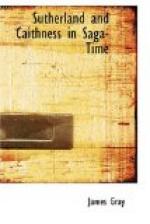About the eighth century and probably earlier, immigrants from the southern shores of the Baltic pressed the Norse westwards in Norway, and later on over-population in the sterile lands which lie along Norway’s western shores, drove its inhabitants forth from its western fjords north of Stavanger and from The Vik or great bay of the Christiania Fjord, whence they may have derived their name of Vikings, across the North Sea to the opposite coasts of Shetland, Orkney and Cat, where they found oxen and sheep to slaughter on the nesses or headlands, and stores of grain, and some silver and even gold in the shrines and on the persons of those whom they attacked, and in still later days they sought new lands over the sea and permanent settlements, where they would have no scat to pay to any overlord or feudal superior.
When the Vikings landed, superior discipline, instilled into them by their training on board ship, superior arms, the long two-handed sword and the spear and battle-axe and their deadly bows and arrows, and superior defensive armour, the long shield, the helmet and chain-mail, would make them more than a match for their adversaries.[12] Above all, the greater ferocity of these Northmen, ruthlessly directed to its object by brains of the highest order, would render the Pictish farmer, who had wife and children, and home and cattle and crops to save, an easy prey to the Viking warrior bands, and the security of his broch would of itself tend to a passive and inactive, rather than an offensive, and therefore successful defence.
After long continued raids, the Vikings no doubt saw that much of the land along the shore was fair and fertile compared with their own, and finally they came not merely to plunder and depart, but to settle and stay. When they did so, they came in large numbers and with organised forces[13] and carefully prepared plans of campaign, and with great reserves of weapons on board their ships; and having the ocean as their highway, they could select their points of attack. They then, as we know from the localities which bear their place-names, cleared out the Pict from most of his brochs and from the best land in Cat, shown on the map by dark green colour, that is, from all cultivated land below the 500 feet level save the upper parts of the valleys; or they slew or enslaved the Pict who remained. Lastly, on settling, they would seize his women-kind and wed them; for the women of their own race were not allowed on Viking ships, and were probably less amenable and less charming to boot. But the Pictish women thus seized had their revenge. The darker race prevailed, and, the supply of fathers of pure Norse blood being renewed only at intervals, the children of such unions soon came to be mainly of Celtic strain, and their mothers doubtless taught them to speak the Gaelic, which had then for at least a century superseded the Pictish tongue. The result was a mixed race of Gall-gaels or Gaelic strangers, far more Celtic than Norse, who




